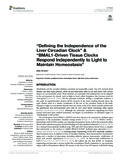Mostrar el registro sencillo del ítem
'Defining the independence of the liver circadian clock' & 'BMAL1-driven tissue clocks respond independently to light to maintain homeostasis'
| dc.creator | Rotinen Díaz, Mirja Sofia | es_ES |
| dc.date.accessioned | 2020-07-03T12:54:12Z | |
| dc.date.available | 2020-07-03T12:54:12Z | |
| dc.date.issued | 2020 | |
| dc.identifier.issn | 1662-4548 | |
| dc.identifier.uri | https://hdl.handle.net/2454/37302 | |
| dc.description.abstract | These studies demonstrate that peripheral tissues and organs can detect changes in environmental light and are capable of maintaining some basic functions, independently from our brain clock. The liver can autonomously ensure glucose homeostasis even if there is a glitch in the feedback system to the central clock (SCN). This could be of critical importance in environmentally challenging conditions to the organism. Our body needs to find a fine balance between diving into adjust its clocks in response to environmental stimuli and opposing change; otherwise we would live in a constant jet lag state. These studies provide evidence of the existence of at least two pathways regulating peripheral circadian clocks to reach that equilibrium. The first is an 'immediate and autonomous' response that allows organs to adjust to changes in light, without any input from other circadian clocks. The latter works as a 'fail safe copy' of past light regime that guarantees a certain degree of resistance and robustness to environmental changes, which is sustained by signals coming from other organs. Future studies will need to examine how the autonomous circadian clocks become deregulated in pathological contexts (obesity, metabolic disease, diabetes…). | en |
| dc.description.sponsorship | This work was supported by The Spanish Ministry of Science, Innovation and Universities (Ramón y Cajal programme: RYC-2018-023874-I). | en |
| dc.format.extent | 3 p. | |
| dc.format.mimetype | application/pdf | en |
| dc.language.iso | eng | en |
| dc.publisher | Frontiers Media | en |
| dc.relation.ispartof | Frontiers in Neuroscience, 2020, 14, 107 | en |
| dc.rights | © 2020 Rotinen. This is an open-access article distributed under the terms of the Creative Commons Attribution License (CC BY). The use, distribution or reproduction in other forums is permitted, provided the original author(s) and the copyright owner(s) are credited and that the original publication in this journal is cited, in accordance with accepted academic practice. No use, distribution or reproduction is permitted which does not comply with these terms. | en |
| dc.subject | Circadian | en |
| dc.subject | Peripheral clocks | en |
| dc.subject | Transcription factor | en |
| dc.subject | Light-dark cycles | en |
| dc.subject | Autonomous | en |
| dc.title | 'Defining the independence of the liver circadian clock' & 'BMAL1-driven tissue clocks respond independently to light to maintain homeostasis' | en |
| dc.type | info:eu-repo/semantics/article | en |
| dc.type | Artículo / Artikulua | es |
| dc.contributor.department | Ciencias de la Salud | es_ES |
| dc.contributor.department | Osasun Zientziak | eu |
| dc.rights.accessRights | info:eu-repo/semantics/openAccess | en |
| dc.rights.accessRights | Acceso abierto / Sarbide irekia | es |
| dc.identifier.doi | 10.3389/fnins.2020.00107 | |
| dc.relation.publisherversion | https://doi.org/10.3389/fnins.2020.00107 | |
| dc.type.version | info:eu-repo/semantics/publishedVersion | en |
| dc.type.version | Versión publicada / Argitaratu den bertsioa | es |


